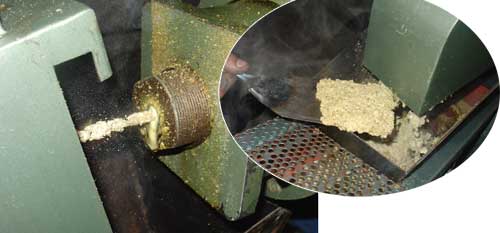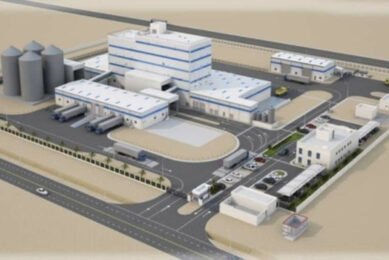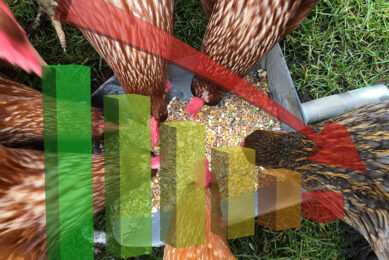Extruding full fat soy for maximum quality

Soybeans prior to oil extraction are referred to as full fat soybeans. Properly processed full fat soybeans are a valuable feed ingredient because of their energy, protein, linoleic acid, vitamin E and lecithin contents. There are a number of different products on the international market being sold as full fat soybean meal. These products are produced by a variety of processes, all of which have a different impact on the nutritive value of the product and its quality in terms of antinutritional factor levels. The focus of this paper is using extrusion technology to process quality full fat soybeans for animal feeding.
a) Trypsin and chymotrypsin inhibitors;
b) Phytohaemagglutinins (Lectins);
c) Urease;
d) Allergenic factors; and
e) Lipases and Lipoxygenases.
Methods of producing full fat soybean meal
There are a number of different products on the international market being sold as full fat soybean meal. These products are produced by a variety of processes, all of which have a different impact on the nutritive value of the product and its quality in terms of antinutritional factor levels.
Full fat soybeans are thermally processed to destroy anti-nutritional factors and to increase oil availability while preserving the nutritional quality of the protein. The major anti-nutritional factor of concern in raw soybeans is a trypsin inhibitor. Trypsin inhibitor is a protease that is harmful to most animals and humans, and nutritionists have documented this effect conclusively. This protease enzyme can be inactivated by heat treatment. A reduction of at least 85% of the trypsin inhibitor units is considered necessary by feed technologists to avoid nutritional problems.
(Vitamin E) for a better digestion and stability and to facilitate the physical extraction of the oil The cooked full fat soybean can then immediately enter a mechanical press where the majority of the oil is removed. This oil can be used for other processing including bio-diesel and the production of oils that are “natural” since they have not been through a traditional hexane extraction process. The cake can be used as a protein source for animal feeds.
Heat treatment through extrusion increases the by-pass protein for ruminants. In dry extrusion utilizing the inherited moisture in the soybeans (9-11%) is sufficient enough to denature the protein without affecting the primary structure or changing the optimum extrusion temperature of 150-160 ºC. However, some processors may choose to exceed those parameters by increasing the temperature even more to assure a higher by-pass protein. This will, however, be accompanied by minor discoloration or browning of the full fat soybean meal. The amount of denatured or by-pass protein produced during extrusion may be quantified by determining the Nitrogen Solubility Index (% NSI) of the final product.
Extrusion is a continuous process and has obvious advantages over simple batch cooking processes like boiling or autoclaving. It is also quicker than boiling since the beans have to be kept at boiling point for about 30 min to achieve reasonable levels of inhibitor destruction. The main variables associated with product quality and process efficiency as far as soybean processing is concerned are time, temperature, moisture content and the degree of physical damage needed to render the oil content more digestible. Extrusion is a readily controllable process where temperature, time (to some extent), moisture content and the degree of physical damage can all be manipulated. The net result of this is that a very high quality product can be produced when the extrusion process is properly handled.
| Magnified examples of correct (left) and incorrect extruded full fat soybeans | |
Dry extruders are single screw extruders with a segmented screw put together around the shaft. In between the screw a restriction (steam lock, choke plate) of different diameters can be placed to increase the cook and shear. When material moves in the barrel, and comes across these restrictions, it is unable to pass through, and consequently, pressure builds up and a back flow is created. Usually these restrictions are arranged in such a way that they increase in diameter toward the die end of the screw creating more pressure and shear as they reach the die. This build up of pressure and temperature, together with shear stresses developed, tends to plasticise (gelatinise) the raw materials into viscous paste or puffed shape, depending upon the raw material. In dry extrusion, pressure and temperature should be at a maximum just before leaving the die.
Higher shaft speed
Most standard dry extruders are manufactured in such a way that the speed of rotation of the main shaft is around 550 revolutions per minute (rpm). This shaft speed is ideal for general purpose use where everything from cereal starch to full fat soybeans needs to be processed in the same machine. However, if the machine is to be used exclusively for full fat soybean meal production, a slightly higher shaft speed (around 620 rpm) is necessary in combination with an extended three chamber barrel, since this will give a higher throughput per hour without compromising product quality.
Preconditioning increases output
Recently, several developments have occurred in dry extruder design and its components. Recent research has shown that if the starting material can be preconditioned with steam, the efficiency of the extruder increase almost doubled. Such technology can also reduce the wear of the extruder barrel components by 20%, reduce the electricity cost by around 40%,
Method varies oil content
Since nothing is added or taken away in the full fat soy process, the gross composition of full fat soy will depend on a constant moisture basis. The most serious variation is with the level of moisture of the beans and the percentage of impurities such as dust, straw or weed seed among others. Full fat will obviously contain the same level of oil as found in whole soybeans with a similar moisture basis.
| To obtain maximum throughout and the desired output quality the extruder configuration is frequently examined and re-adjusted |
The average oil content of full fat soy will be 17-18% if determined by the Soxhlet method using petroleum ether. This figure will be higher if oil is determined by the acid hydrolysis method. The oil in full fat soy which is properly processed by extrusion is very stable and provides a remarkable long shelf life for such a high fat product.
 Beheer
Beheer











 WP Admin
WP Admin  Bewerk bericht
Bewerk bericht